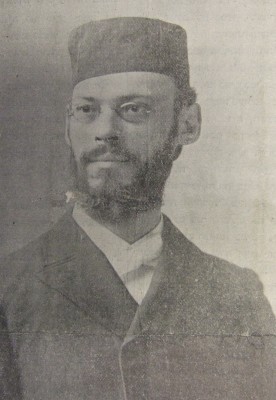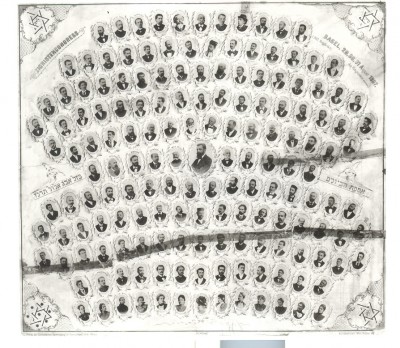The American Delegate(s)* at the First Zionist Congress

Written by Avi Y. Decter. Originally published in Generations 2007-2008: Maryland and Israel
In August 1897, Rabbi Dr. Schepsel Schaffer (1862 – 1933) of Baltimore traveled up to New York to embark for Europe. His destination was Basel, Switzerland, where the first World Zionist Congress was convening. Rabbi Schaffer’s departure was trumpeted on the front page of at least one New York Jewish newspaper, and echoes of his trip to Basel still resonate today.

In the pantheon of early American Zionists, Rabbi Schaffer occupies a special place. Rabbi Schaffer was an ardent advocate of Zionism throughout his career. In 1895 he became president of the Baltimore Zion Association, Hevrat Zion, which was then one of the largest local Zionist groups in America.[1] When the Federation of American Zionists, predecessor of the Zionist Organization of America, was organized in 1898, Rabbi Schaffer was chosen as one of its original vice presidents, and when the Mizrachi [Religious Zionists] of America Organization was established in 1913 Rabbi Schaffer was named to its first Governing Council. He remained active in the Mizrachi movement for many years[2].
Any of these leadership activities would have been sufficient to ensure Rabbi Schaffer’s place of honor in American Zionist history. However, during the past century, Rabbi Schaffer’s fame as a Zionist leader has rested mostly on his participation in the first World Zionist Congress, where he was the only “official delegate from the United States representing an existing Zionist organization.”[3]

Pioneers (“the first”) and singularities (“the only”) often stand out, and, as a result, are frequently the stuff of popular history. The fact that Rabbi Schaffer was the only “official delegate” from an American Zionist organization at the first World Zionist Congress has been repeated in one variation or another for generations, and it is now deeply embedded in Zionist historiography and in collective memory, especially here in Maryland. Of course, decades of imprecise usage has led to some inaccuracies. In one account, Rabbi Schaffer was “the only delegate from the United States;” in another, he was “the sole American representative;” and in still another, the Rabbi was “the representative of the Zionists of America.”[4]
In fact, four participants at the first Zionist Congress signed in from the United States; we also know that two of these participants were listed as “delegates.”[5] Who attended from the United States, and how did they get there? What, precisely did it mean to be a “delegate” to the first World Zionist Congress? And why is this important, anyway?
Continue to Part II: The Congress Participants
Notes:
[1] Hamelitz 1897, no. 44, p. 2 cited in Isaac Fein, The Making of an American Jewish Community: The History of Baltimore Jewry from 1773 to 1920 (Philadelphia: Jewish Publication society of America, 1971), note 245. See also Marnin Feinstein, American Zionism, 1884 – 1904 (New York: Herzl Press, 1965), 52, 95, and 142.
[2] Moshe Sherman, Department of Hebraic Studies, Rutgers University, “Schaffer, Shepsel (1862 – 1933),” January 1998 research note in the :Bridges to Zion” exhibition files, Jewish Museum of Maryland Institutional Archives; “Rev. Dr. Schepschel Schaffer’s 25th Anniversary as Rabbi of Shearith Israel Congregation,” Jewish Comment, January 4, 1918; Reverend Doctor Schepschel Schaffer: Twenty-Five Years of Activity in the Cause of Orthodox Judaism, 1893 – 1918 (Baltimore: Congregation Shearith Israel, 1918).
[3] “Schaffer, Schepsel,” in Raphael Patai, ed., Encyclopedia of Zionism and Israel (New York: McGraw-Hill, 1971), vol. 2, 1000.
[4] Fein, Making of an American Jewish Community, 195; Yitzchok Levine, “Glimpes Into American Jewish History Part 34: Forty Years of Baltimore’s Congregation SHearith Israel,” 2, at llevine@stevens.edu; “Rev. Dr. Schepschel Schagger’s 25th Anniversary.” Other variations include “the only United States delegate to the first Zionist Congress,” Baltimore Sun, March26, 1975; “the one official delegate,” Gerald Sorin, A Time for Building: The Third Migration, 1880 – 1920 (Baltimore: Johns Hopkins University Press, 1992), 223; the “only…official delegate [of an American Zionist organization],” Melvin Urofsky, American Zionism from Herzl to the HolocaustI (Garden City, N.Y.: Anchor Press, 1975), 86; and “the only official delegate, representing an existing organization,” Feinstein, American Zionism, 104.
[5] The Congress published its own list of participants while it was in session. A copy of this pamphlet is found at the Central Zionist Archives in Jerusalem: Praesence-Liste des Zionisten Congresses 1897 – 5657, Basel, den 29, 30., und 31. August, Basel, 1897. Both Rabbi Schaffer and Adam Rosenberg are marked by asterisks, indicating a delegate from an organization or community. The Jewish Encyclopedia (New York: Funk & Wagnalls, 1916), Vol. 12, 675 notes that “Among the delegates there were representatives of the various Jewish national bodies, though most of the members came in their private capacity.”
